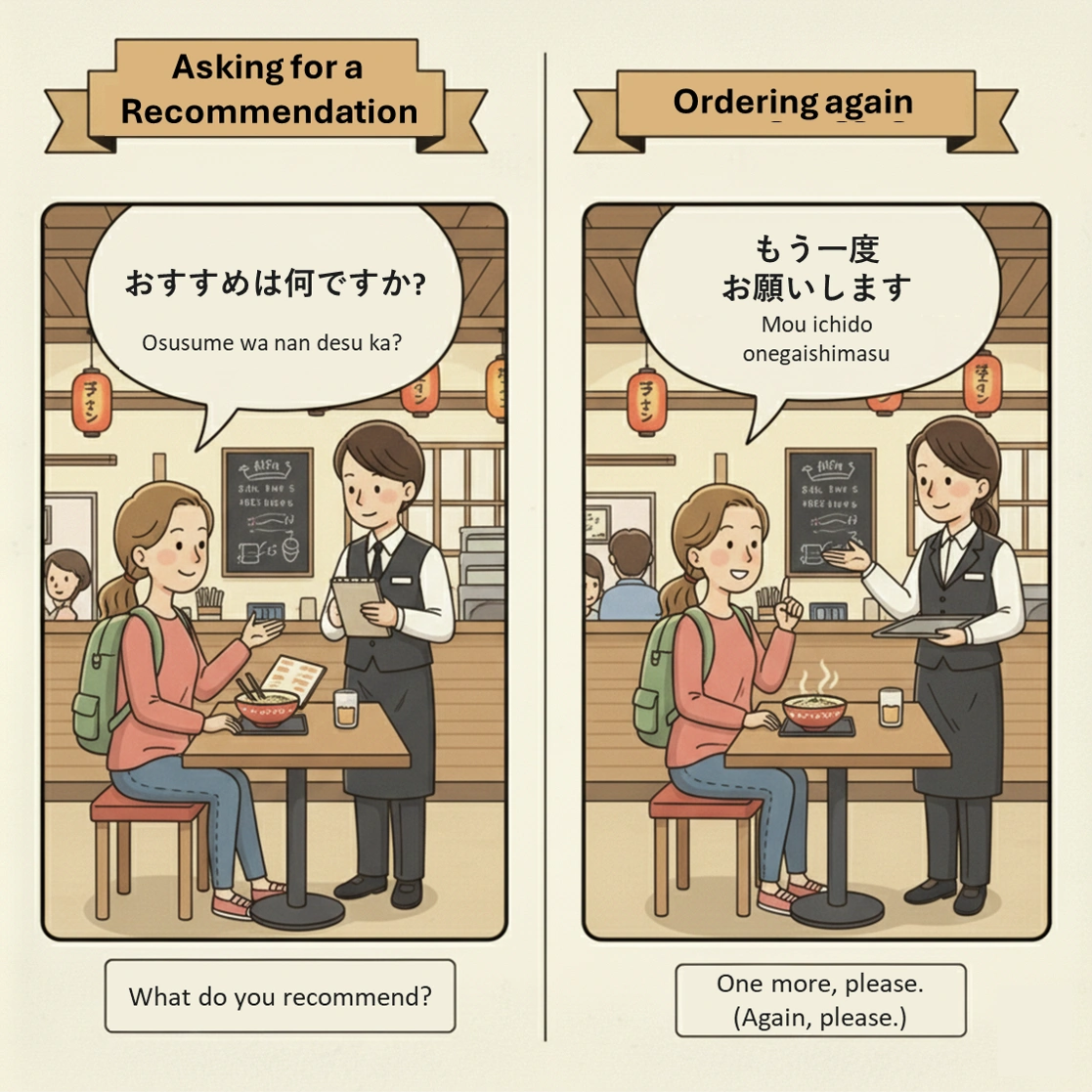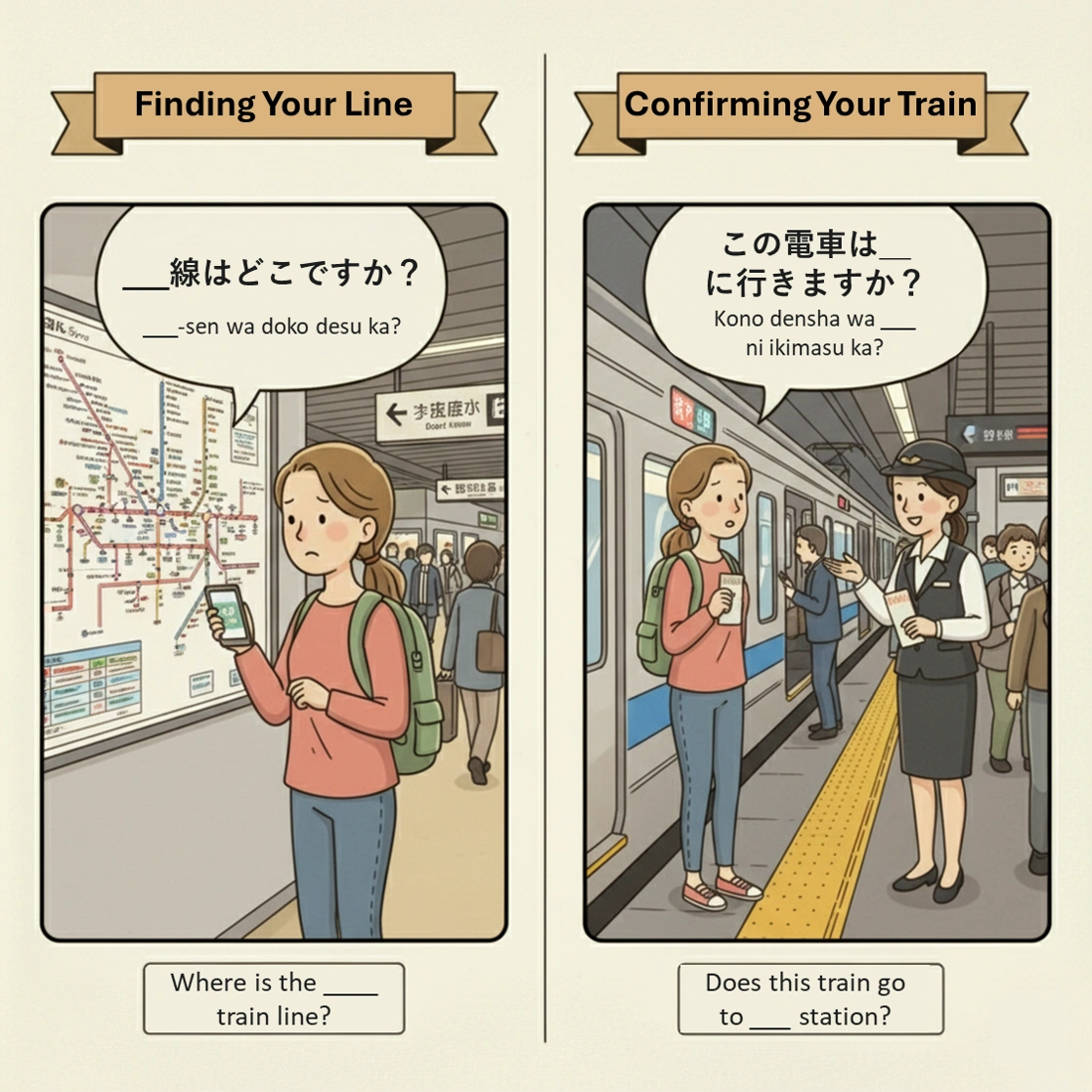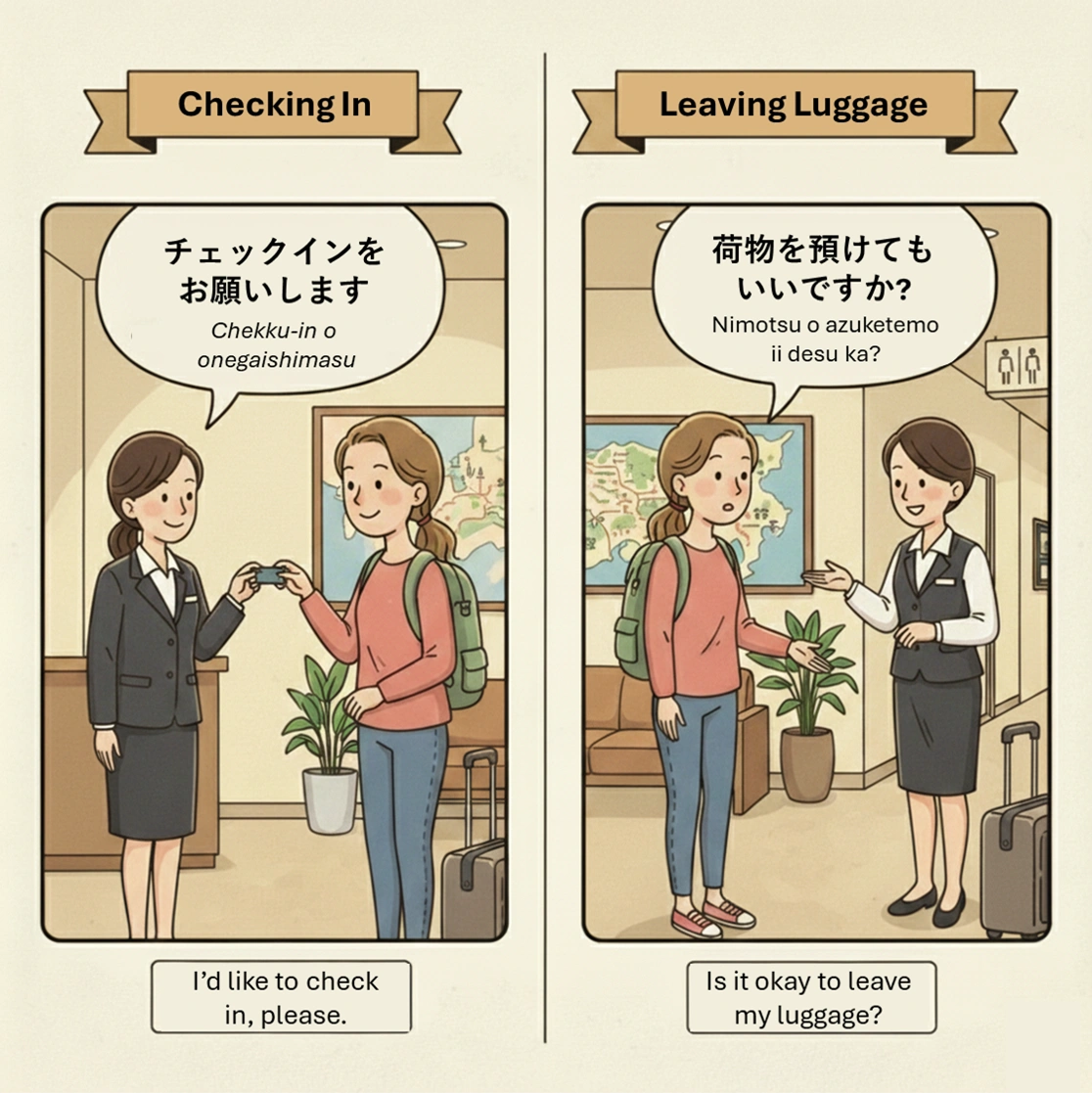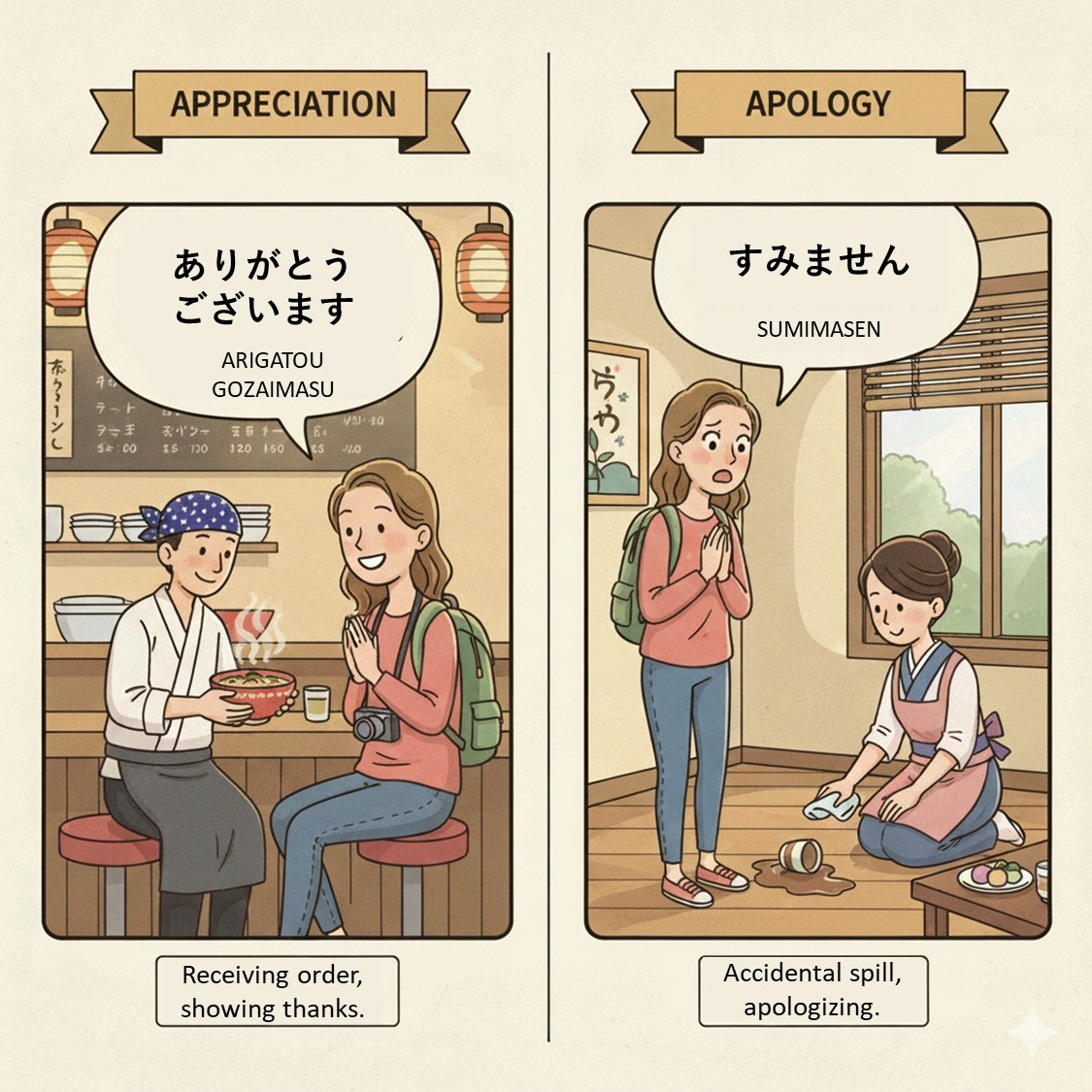25 Essential Japanese Restaurant Phrases for Confident Dining
Published: November 11, 2025 | Reading Time: 10 minutes
Japanese food is famous around the world, and eating out in Japan is a unique experience. Whether you're at a small sushi bar or a lively izakaya, using the right phrases can turn your meal into a real cultural exchange. Even though many places in tourist areas have English menus and staff who speak some English, learning a few key phrases shows respect and can help you get better service, useful recommendations, and more memorable moments with the chefs and staff.

On This Page
1. Why Restaurant Phrases Matter2. Entering & Getting Seated3. Ordering Food & Drinks4. Dietary Restrictions & Special Requests5. During Your Meal6. Paying & Leaving7. Restaurant Etiquette Tips8. Frequently Asked Questions1. Why Restaurant Phrases Matter
Dining etiquette is really important in Japanese culture. Using the right phrases shows you understand and respect these customs. More practically, these phrases help you when English isn't available and make sure you get what you want (or avoid what you don't want).
"Itadakimasu" before eating and "Gochisousama deshita" after aren't just phrases—they're ways of showing gratitude that connect you to Japanese food culture.
These phrases work everywhere from casual ramen shops to fancy kaiseki restaurants. The formality level is already built in, so you can use them confidently anywhere.
2. Entering & Getting Seated
First impressions matter. These phrases help you make a reservation, tell them how many people you have, and get seated without any trouble.
- 予約をお願いしますYoyaku o onegaishimasuI'd like to make a reservation, please
Call ahead for popular restaurants. Many take reservations online, but this phrase helps when you're calling.
- 二名ですNi-mei desuParty of two
Replace "ni" (two) with: ichi (1), san (3), yon (4), go (5), roku (6). Add "-mei" after the number to indicate people.
- 禁煙席をお願いしますKin'en seki o onegaishimasuNon-smoking seat, please
While smoking sections are becoming less common, some izakayas still have them. For smoking: "Kitsuen seki" (喫煙席).
- 窓側の席はありますか?Madogawa no seki wa arimasu ka?Do you have a window seat?
Perfect for restaurants with views. You can also ask for "Kaunta- seki" (counter seat) at sushi bars.
Cultural Note: "Irasshaimase!"
When you walk into most Japanese restaurants, the staff will greet you with a cheerful "Irasshaimase!" (いらっしゃいませ - Welcome!). You don't need to say anything back—just smile and nod a bit. This is standard greeting, not a question that needs an answer.
3. Ordering Food & Drinks
These are your go-to ordering phrases. When you combine them with pointing at a menu or picture, you'll be able to order anything with confidence.
- メニューをお願いしますMenyuu o onegaishimasuMenu, please
Some restaurants bring menus automatically, but this is helpful when they don't.
- おすすめは何ですか?Osusume wa nan desu ka?What do you recommend?
A great way to find out what's special at the restaurant. Staff recommendations are usually really good.
- これをお願いしますKore o onegaishimasuThis one, please
The universal ordering phrase. Point at the menu item and say this.
- 同じものをくださいOnaji mono o kudasaiThe same thing, please
Useful when your companion orders something that looks delicious.
- お水をくださいO-mizu o kudasaiWater, please
Most restaurants provide free water. You can also request "Ocha" (green tea) at many casual restaurants.
- ビールを二つくださいBiiru o futatsu kudasaiTwo beers, pleaseNumbers for ordering: hitotsu (1), futatsu (2), mittsu (3), yottsu (4), itsutsu (5)
Replace "biiru" with any drink: sake, wain (wine), uisukii (whiskey), kohii (coffee).
Building Restaurant Vocabulary
Reading Japanese menus gets much easier when you can recognize common kanji and food words. Regular exposure to real Japanese content helps you naturally pick up food terms, seasonal ingredients, and cooking methods you'll see on menus.
Reading tools like YoMoo give you daily articles about Japanese food culture, restaurant reviews, and seasonal ingredients—exactly the vocabulary you need for confident dining.
4. Dietary Restrictions & Special Requests
Telling people about allergies and dietary restrictions is really important. Vegetarian and vegan options can be tricky in Japan, but these phrases help you stay safe and get what you need.
- アレルギーがありますArerugii ga arimasuI have an allergy
Follow with the ingredient: "Ebi ni arerugii ga arimasu" (I'm allergic to shrimp). Common allergens: tamago (egg), gyuunyuu (milk), komugi (wheat), soba, piinattsu (peanuts).
- ___は食べられません___ wa taberaremasenI cannot eat ___
More general than saying you have an allergy. Fill in with: niku (meat), sakana (fish), buta (pork), gyu (beef).
- ベジタリアンですBejitarian desuI'm vegetarian
Note: Many Japanese dishes use dashi (fish stock). You may need to specify "Dashi mo dame desu" (No dashi either).
- 辛くないものはありますか?Karakunai mono wa arimasu ka?Do you have anything not spicy?
Japanese food isn't typically very spicy, but some dishes (like curry or certain ramen) can be.
- 少なめでお願いしますSukuname de onegaishimasuA small portion, please
For "large portion": "Oomori de onegaishimasu" (大盛りでお願いします).
Important for Allergies
If you have serious allergies, think about carrying an allergy card in Japanese that clearly lists what you're allergic to. Many websites offer free printable versions. Show this to staff when you order to make sure they understand and can keep you safe.
5. During Your Meal
These phrases help you enjoy your meal fully and talk with staff throughout your time at the restaurant.
- いただきますItadakimasuThank you for this meal (said before eating)
One of the most important Japanese phrases. Say this before you start eating. It shows gratitude for the food and everyone who made it possible.
- おいしいですOishii desuIt's delicious
A simple compliment that always brings smiles. In casual settings, you can just say "Oishii!"
- すみませんSumimasenExcuse me
Your go-to phrase for getting a server's attention. Never snap your fingers or wave frantically—a polite "Sumimasen" with eye contact works great.
- お箸をくださいO-hashi o kudasaiChopsticks, please
Replace "hashi" with: foku (fork), spuun (spoon), naifu (knife), oshibori (wet towel), napukin (napkin).
- もう一度お願いしますMou ichido onegaishimasuOne more, please / Again, please
Perfect for ordering another round of drinks or another serving of your favorite dish.
6. Paying & Leaving
In Japan, you usually pay at the register near the exit instead of at your table. These phrases help you handle payment smoothly.
- お会計をお願いしますO-kaikei o onegaishimasuCheck, please
You can also make an "X" gesture with your index fingers as a universal sign. Many restaurants have you pay at the front register rather than at the table.
- クレジットカードは使えますか?Kurejitto kaado wa tsukaemasu ka?Can I use a credit card?
While more and more places take cards, some smaller restaurants are still cash-only. Always good to check first.
- 別々でお願いしますBetsu-betsu de onegaishimasuSeparate checks, please
Splitting bills isn't as common in Japan, and some restaurants may not accommodate this. It's easier to have one person pay and settle up later.
- ごちそうさまでしたGochisousama deshitaThank you for the meal (said after eating)
The companion phrase to "Itadakimasu." Say this when you're done eating and especially when leaving. It's a respectful way to show your appreciation.
- ありがとうございましたArigatou gozaimashitaThank you very much (past tense)
Say this as you leave. The past tense (-mashita) is used because the service has been completed.
Tipping Culture in Japan
Tipping isn't done in Japan and can actually be seen as rude or confusing. Great service is expected as the standard. If you try to leave a tip, staff might even run after you thinking you forgot your change! Show appreciation through your words instead: "Oishikatta desu" (It was delicious) and "Arigatou gozaimashita" mean way more than money.
7. Restaurant Etiquette Tips
Beyond phrases, understanding basic restaurant etiquette will help you feel more confident and avoid accidentally breaking cultural rules.
Do:
- Wait to be seated—don't choose your own table
- Say "Itadakimasu" before eating
- Slurp your noodles—it's a compliment!
- Use the serving chopsticks (tori-bashi) for shared dishes
- Place your chopsticks on the holder between bites
- Pay at the register, not at the table
Don't:
- Stick chopsticks upright in rice (funeral ritual)
- Pass food chopstick-to-chopstick (funeral ritual)
- Pour soy sauce directly on rice
- Talk loudly—Japanese restaurants are typically quiet
- Leave a tip
- Walk around while eating
Explore the "Essential Phrases" Series
Mastering everyday situations is key to a smooth trip. Continue building your confidence with our other guides in this series:




8. Frequently Asked Questions
Do I need to make reservations at Japanese restaurants?
How do I know if a restaurant accepts credit cards?
What's the difference between "Itadakimasu" and "Gochisousama"?
Is it rude to not finish all my food in Japan?
How do I handle food allergies or dietary restrictions in Japan?
What should I do if I don't understand the menu?
Final Thoughts
Dining in Japan is about more than just food—it's a cultural experience full of respect, gratitude, and attention to detail. Master "Itadakimasu," "Gochisousama deshita," and "Sumimasen," and you'll be able to handle any restaurant with confidence. The effort you make to speak Japanese, even if it's not perfect, will be really appreciated and often rewarded with warm service and memorable moments.